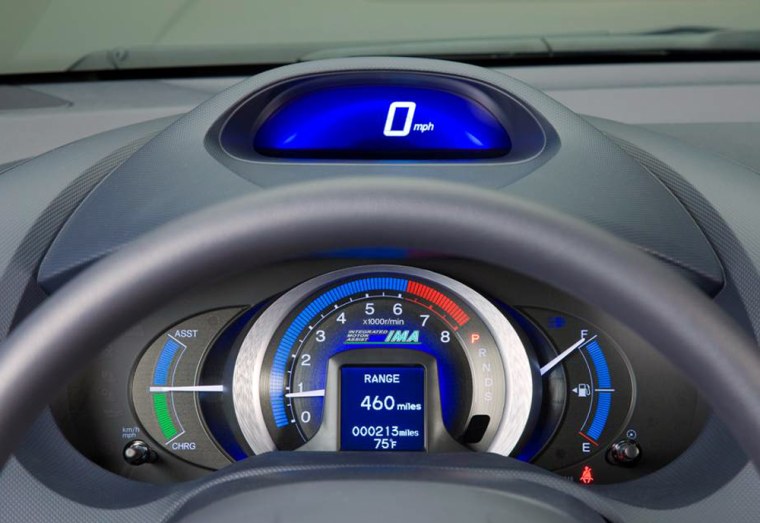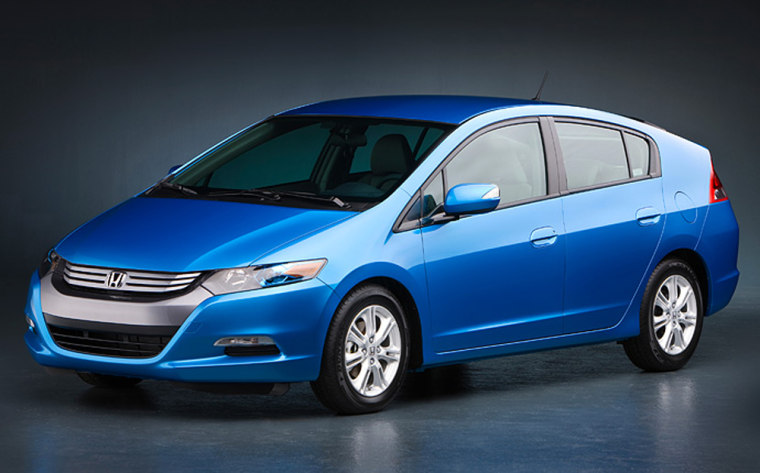During boom times, value can go out of style, as dedicated followers of fashion pursue the latest trends and jockey for position in the social order with their accoutrements.
Whether it is outsized McMansions or blinged-out SUVs, when the economy is expanding, more consumers feel entitled to show off a bit. Advertisements cater to such impulses, counseling people that they deserve to treat themselves to something special.
Increasing interest in value should make the 2010 Honda Insight hybrid a popular choice, whenever people decide to start buying cars again. Once people open their wallets, they will likely do so with a mind to maximize their value, and the Insight will be waiting for them.
“We have a great deal of confidence that the Insight is the right car at the right time,” said Dan Bonawitz, vice president of logistics for American Honda.
Some might say that value is synonymous with fuel economy. But while efficiency plays a part — because we don’t want to get hijacked at the pump next time prices swing north of $3 — value for car consumers has more to do with purchase price and practicality.
That’s why tiny fuel-efficient cars like the original two-seat Insight have sold poorly, and it’s also why many shoppers who liked the combination of spaciousness and efficiency in Toyota’s Prius were put off by its price — now around $23,500.
Honda’s goal in designing the 2010 Insight was to find the value sweet spot, and it looks like they’ve hit it. The Insight marks the best intersection yet of the plots for price, efficiency and practicality.
Engineers accomplished this by designing a hybrid system with a priority on cost rather than maximum efficiency, scoring more bang for the buck than glittering technology showcases that no one can afford. They wrapped it in a five-door hatchback body that packs maximum cabin space into minimal physical size.
Many more hatchbacks are likely to come to market in the next few years, as consumers respond rationally to the design’s inherent flexibility, but in the meantime Insight drivers can appreciate the ability to fold down the rear seats and slide in large objects from the hatch’s load floor.
While Honda engineers sought a rational balance between cost and efficiency in the Insight’s hardware, they included software aimed at making the car more efficient by coaching the driver to go light on the gas pedal.

While the Prius and other hybrids have long featured video displays of fuel economy worthy of a Mario Brothers video game, Honda recognized the benefit of a simple approach: The color of the speedometer display changes to indicate relative efficiency without distracting the driver from the task of driving (the Insight’s speedometer is high-mounted at the base of the windshield, so that a driver can notice the color while still looking down the road).
The greener the display, the greener the driving. Floor it, and the speedometer quickly shifts to blue — this gives the driver a clear indication that he’s not driving as efficiently as he could. (I felt blue was sort of benign. A nice angry red might well have been aesthetically jarring, but it would have delivered an even more unmistakable message.)
The Insight’s onboard computer doesn’t stop with fuel economy. It not only shouts driving suggestions in real time like a soccer parent on the sidelines, it also keeps track of every detail like an obsessive baseball statistician.
These stats inform a score shown on the dashboard in the form of a series of five plants. Drive green and each of the plants in succession will grow leaves. The goal is to fully leaf-out all five plants, but the scoring is on a curve, so it is harder to grow leaves on each new plant (Beware: leafs earned can be lost by later bad behavior!)
And the car tracks lifetime fuel economy. Again, a note of caution: There are no ways to suspend this lifetime scoring, so valets and mechanics can screw up your hard-earned fuel economy score. Worse yet, there are no settings for different drivers, so look for “Ruined my lifetime fuel economy score” to march up the top ten list of divorce reasons. Hell hath no fury like a woman whose fuel economy has been ruined by an inattentive husband.
Finally, if all this coaching has bounced off the driver’s thick cranium, the computer can directly intervene to prevent the driver from wasting gas.
Press the “Econ” button and the throttle-by-wire system will replace the virtual throttle cable with a virtual rubber band. This means throttle response becomes sluggish and elastic, dampening the effects of edgy drivers who ratchet the gas on and off with an approximation of what they wanted, rather than an automatic execution of what they actually requested.
With an automatic continuously variable transmission, this effect is largely invisible, but it does help with the gas mileage, according to Honda. And if you are about to be creamed by a truck and need to go now, pressing the gas to the floor overrides the Econ filter, with the engine room replying “aye, aye” to the order for flank speed.
The Insight’s cabin, like its hybrid drivetrain, was designed with a focus on cutting costs, and it shows. But while the interior features as much hard plastic as a Little Tykes Cozy Coupe play car, the reasonably plush fabric and clean design convey the impression that designers did their best while keeping your purchase price down.
The effect is not of insulting cheapness, just of an obvious frugality that makes the Honda Civic look opulent in comparison. Still, would it kill Honda to offer adjustable lumbar support as at least a band-aid for the crappiness of the Insight’s cheap seats? (The similarly, ahem, inexpensive Chevy Aveo has a lumbar adjuster on the driver’s seat.)
As with the interior appointments, cabin space is also similar to that of the sub-compact Fit, but the low-slung Insight gives up headroom. This isn’t a problem in the front seat, but the back seat lacks headroom for six-footers, and the cabin is just as cramped side-to-side as the Fit.
Of course, neither car would be a good choice for a long-distance trip because of uncomfortable seats and a busy ride, but the era of road-hugging weight is in the rear view mirror. The Insight’s back seat’s comfort is also eroded by a seat back that doesn’t recline and seat bottoms that don’t provide any thigh support.
The doors open and close with a reassuring “thunk,” so it is not as if the car feels flimsy. And the hybrid system is smart enough that it doesn’t feel intrusive when it is regenerating power while braking. The Prius and Civic hybrid commit much more of a lurch as the generator turns kinetic energy into electrical potential energy. Such is the benefit of being the newest iteration of an emerging technology.
More on |
